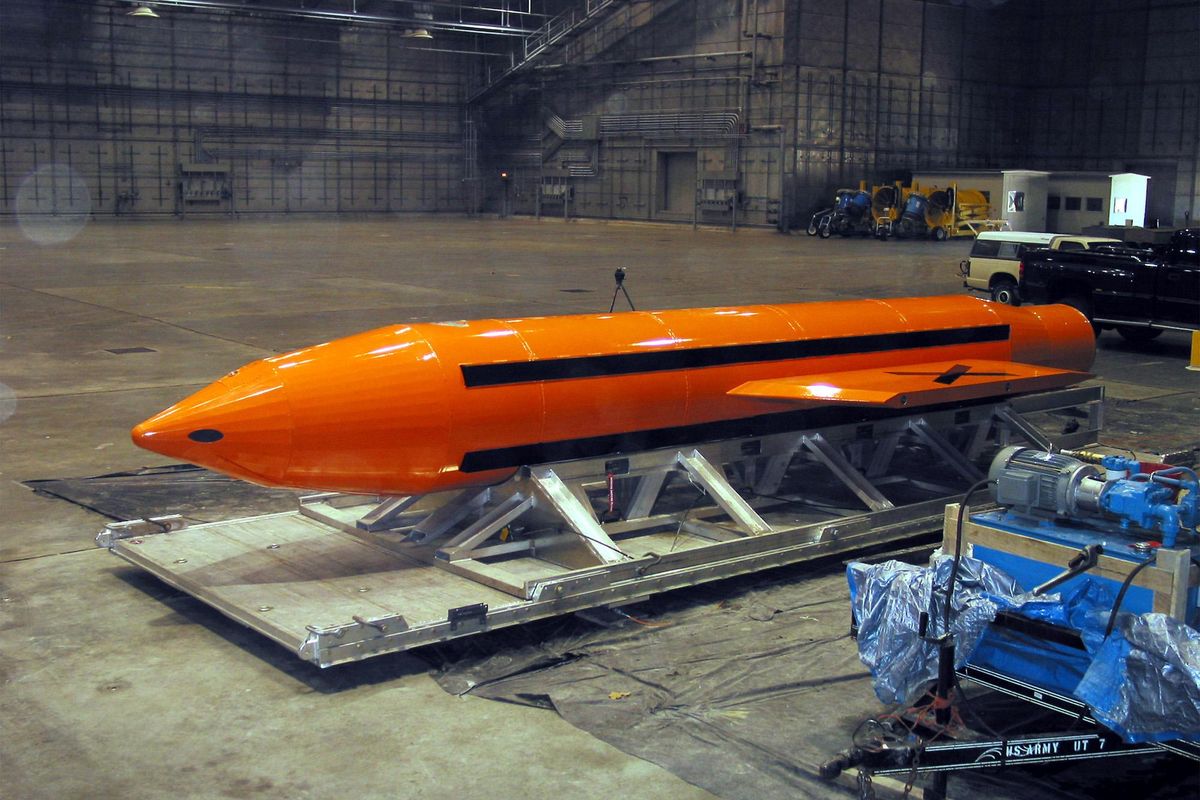U.S. drops largest non-nuclear bomb in Afghanistan

U.S. forces in Afghanistan dropped a 22,000-pound bomb on Islamic State forces in eastern Afghanistan on Thursday, the Pentagon announced, using the largest non-nuclear bomb ever employed in combat.
Gen. John Nicholson, the commander of U.S. forces in Afghanistan, said the bomb was “the right munition” to use against the Islamic State because of the group’s use of roadside bombs, bunkers and tunnels.
The bomb, which is known as the GBU-43, is one of the largest airdropped munitions in the U.S. military’s inventory and was almost used during the opening salvos of the Iraq War in 2003.
By comparison, U.S. aircraft commonly drop bombs that weigh 250 to 2,000 pounds.
The U.S. military has targeted similar complexes and dropped tens of thousands of bombs in Afghanistan, raising the question of why a bomb of this size was used Thursday. It was unclear what the GBU-43 strike accomplished, as the bomb is not designed to penetrate hardened targets such as bunkers or cave complexes.
The Pentagon said in its statement that “U.S. Forces took every precaution to avoid civilian casualties with this strike.”
When asked about the bomb Thursday, President Trump praised the military as the “greatest” in the world. “We have given them total authorization, and that’s what they’re doing, and frankly that’s why they’ve been so successful lately,” he said.
The bomb marked the second time in a week that the Pentagon has launched a high-profile strike. On April 6, the military targeted a Syrian airfield as retaliation for a chemical attack by President Bashar Assad that killed scores of civilians.
A spokesman for U.S. forces in Afghanistan did not respond to a query regarding the bomb’s effects on its intended target, an Islamic State tunnel complex in Nangarhar province.
This particular bomb is not the biggest in the Pentagon’s non-nuclear arsenal. The larger 30,000-pound GBU-57 Massive Ordnance Penetrator, designed for destroying heavily fortified bunker complexes, has never been used outside a test environment. While the GBU-57 is heavier, the GBU-43 has a larger warhead and explosive yield.
The GBU-43 is an evolution of the unguided 15,000-pound BLU-82 bomb. First used in Vietnam, the C-130-launched BLU-82 was often dropped to turn patches of jungle into helicopter landing zones. This earned the BLU-82 the nickname “daisy cutter.” The BLU-82 was used multiple times in the early stages of the war in Afghanistan when U.S. forces were closing in on Osama bin Laden in the mountains of Tora Bora on the Afghanistan-Pakistan border.
The use of the GBU-43 in eastern Afghanistan comes less than a week after a U.S. Army Special Forces soldier was killed fighting in the same region. Army Staff Sgt. Mark R. De Alencar, 37, was mortally wounded by small-arms fire Saturday.
U.S. and Afghan forces have been fighting the Islamic State in Afghanistan since 2015. Special Operations forces from the Army’s Ranger battalions as well as the Green Berets have conducted numerous operations to push militants out of their sanctuaries.
The Taliban, the insurgent group that has fought the United States and the Afghan government since 2001, also clashes with the Islamic State, although many of its members have defected to the terrorist group.
Last week, Navy Capt. Bill Salvin, a spokesman for U.S. forces in Afghanistan, told the Associated Press that the Islamic State in Afghanistan had lost more than half its territory and had 800 fighters spread between two provinces. At the group’s peak strength in Afghanistan, it had more than 3,000 fighters, according to the Pentagon. Salvin added that U.S. forces had carried out more than 400 airstrikes on the Islamic State since the year’s start.
There are 8,500 U.S. troops in Afghanistan, primarily split between counterterrorism operations and supporting the fledgling Afghan military. There are also about 7,000 NATO troops in the country responsible for helping train Afghan troops.
Officials at the Afghan Defense Ministry said they were first alerted to Thursday’s bomb attack through media reports.
“We have nothing officially on this so far, but the goal this year is to annihilate Daesh in the east and any other part of Afghanistan,” ministry spokesman Mohammad Radmanesh said, using the Arabic acronym for the Islamic State.
“We will use whatever force that is available to us, together with Resolute Support, and with the maximum amount of caution so that we don’t cause civilian casualties,” he said.
Hazrat Hussain Mashriqiwal, spokesman for police forces in Nangarhar province, where the bomb was dropped, said that international and Afghan forces had “for days” been involved in operations against the Islamic State affiliate. He also said he was not aware of the specific incident, which U.S. forces said took place about 7:30 p.m. local time.
Nangarhar’s Achin district is a stronghold of the local Islamic State branch in Afghanistan, which U.S. officials say is made up of mostly Pakistani and Uzbek militants. The group, which calls itself Khorasan Province, has struggled to expand beyond Achin and a handful of other districts in the east.